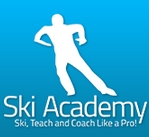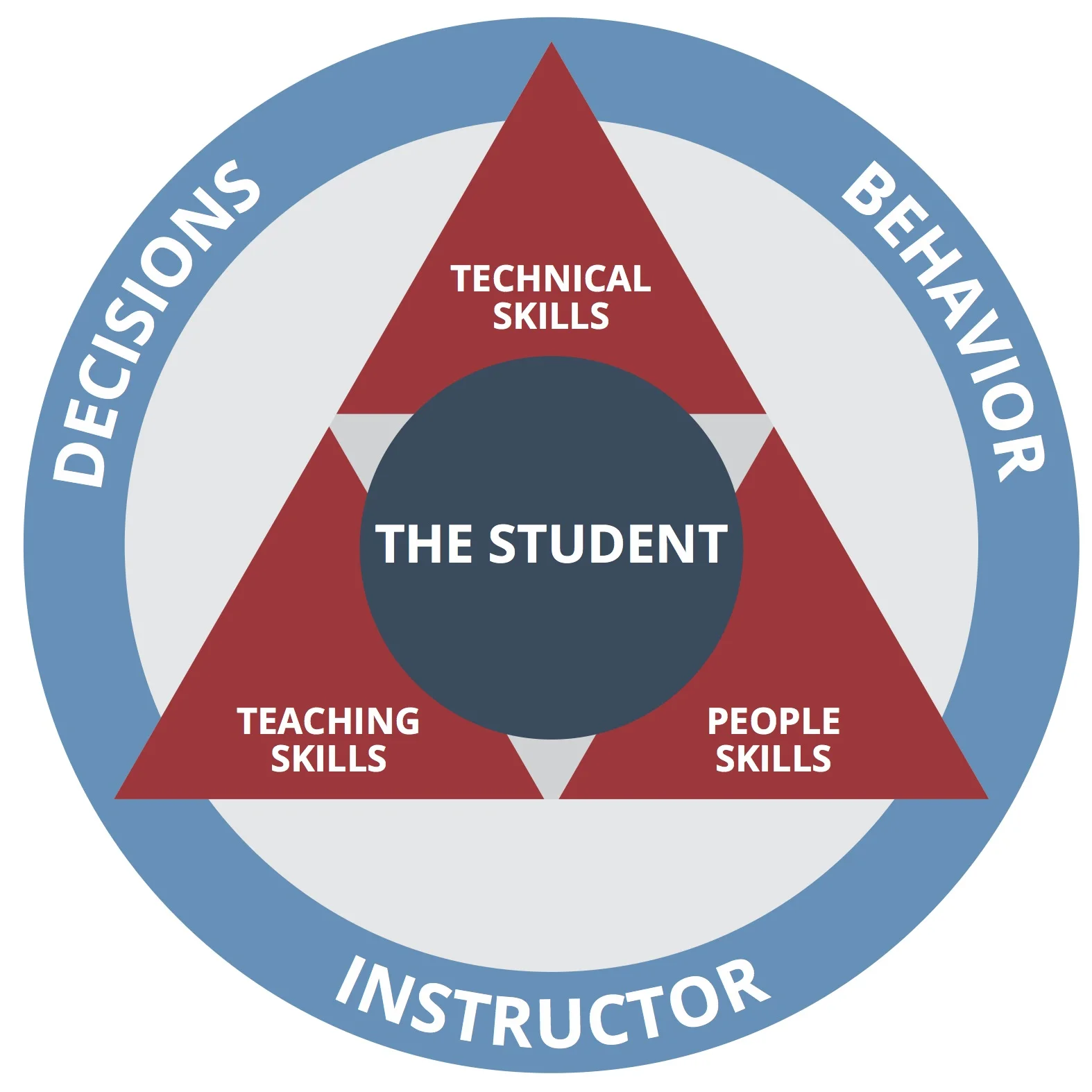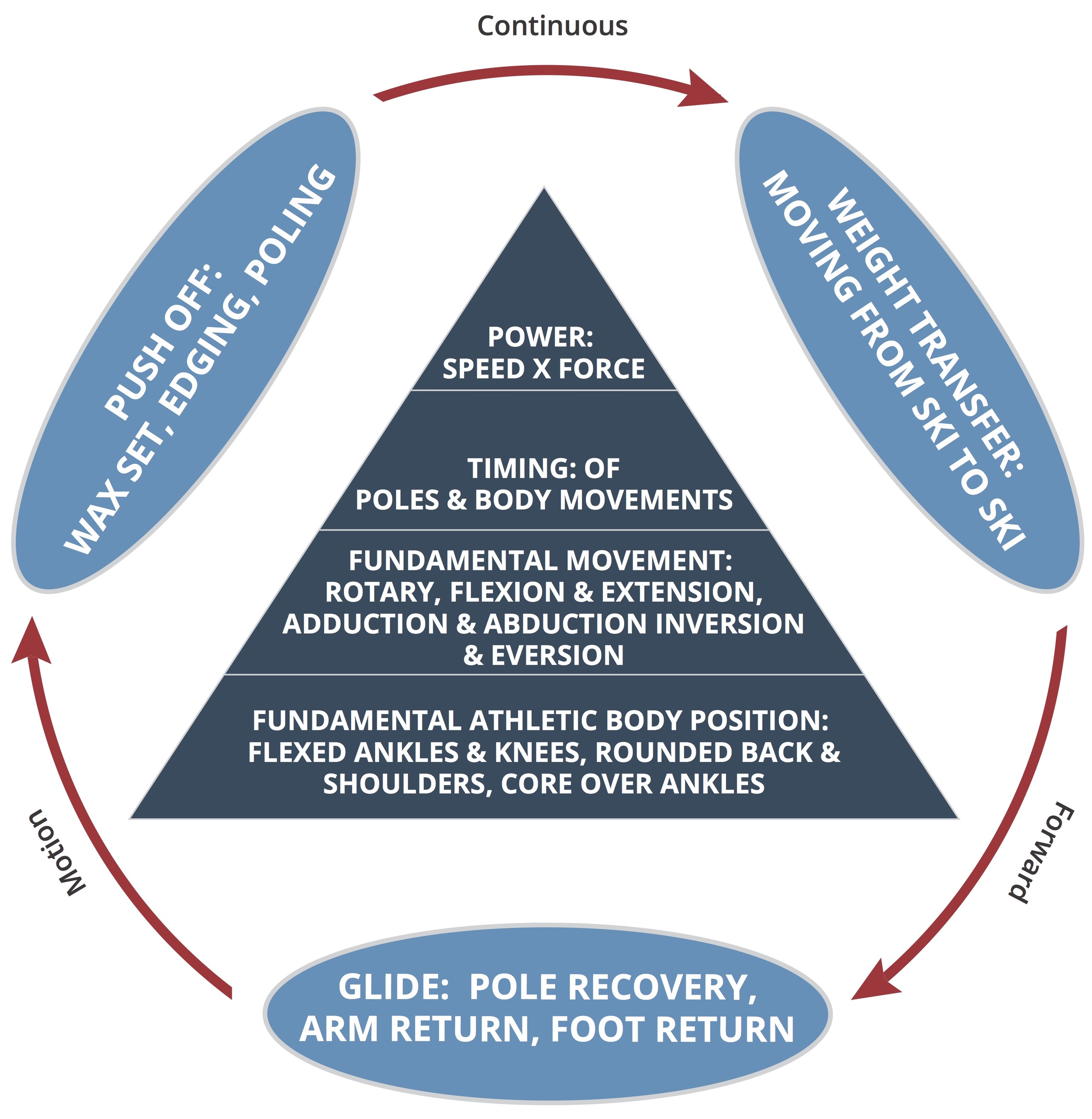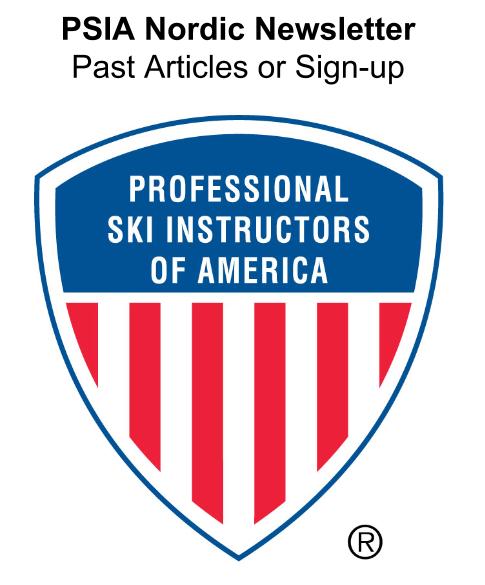Interski 2015 Ushuaia, Argentina: Cross Country Nordic Wrap Up
/Interski 2015 Nordic Cross Country Wrap-Up
Ushuaia, Argentina
by David Lawrence, PSIA Nordic Team, Sept 2015
Cross country nordic skiing at Interski 2015 in Ushuaia, Argentina.
Country: U.S.A.
Overal National Message
Description: Diagram of Learning Connection Triangle.
PSIA-AASI Teams based their Interski 2015 presentation on the Learning Connection Model (see diagram to the right), which emphasizes an equal focus on people skills (which tie into the culture of snowsports), technical skills (which are at the core of good technique), and the teaching skills (which strengthen the student’s connection to snowsports).
People Skills: Student Centered Interpersonal Skills
Interpersonal people skills are used to build trust and target a personal connection to the guest. Empathy based decisions ensure that the guest’s needs and desires are central to the experience. These skills depend upon the instructor’s ability to understand themselves and moderate/adapt their response to the student’s needs and the situation.
Technical Skills: Fundamental Mechanics
The Skills Concept clearly defines the essential actions of the skis or snowboard. Skill blending identifies how to adapt the action of the skis or snowboard to any desired outcome. Skiing/riding fundamentals define the mechanics and movements essential to any ski or snowboard performance outcome. Ski/board performance and movement blends are key to technical proficiency. Biomechanics play a significant role in ski and snowboard movement patterns. The cross country national team's message at Interski focuses most on the technical skills in our new XC Technical Model explained below.
Teaching Skills: Teaching Fundamentals
The instructor’s role is that of a facilitator who helps design the learning environment. The instructor creates learning experiences for students to identify sensations and stimulate emotions. The learning partnership is at the core of this experience. The Teaching Model gives instructors the tools they need to be successful.
The PSIA XC TECHNICAL MODEL:
5 InPSIA-AASI XC Technical Model
At the center of the PSIA-AASI XC Technical Model (see diagram to the right) is the USSA Sports Performance Triangle (body position, movements, timing and power).
The elements that comprise sports performance are not unique to cross country skiing, but are fundamental to all sports like basketball, soccer, football, table tennis, alpine skiing or snowboarding.
The base of the pyramid starts with body position. Body position changes and adjusts to numerous variables throughout the cycle of athletic performance. Body position allows coaches and/or instructors to describe, show or examine what the athlete looks like at any moment in time.
PSIA Nordic team (left to right): Scotty McGee, Ross Matlock, Megan Spurkland, David lawrence
How the athlete moves from one body position to another body position requires the athlete to use fundamental movements (flexion and extension, rotation, abduction, adduction, etc), timing or coordinating the movements together (the right arm moves forward as the left leg moves backward) and power (how hard and fast or slow and easy the athletes moves to create force and speed).
In a propulsion generated sport like cross country skiing, how we move, how we coordinate those movements and how we create power to move over the snow is foundational to the conversation of skiing. Once we combine these sports performance components together, cross country specific fundamentals result.
The 3 fundamentals that both skate and classic skiing share are push-off, weight transfer and glide. These 3 fundamentals help instructors and coaches organize the components of teaching a complicated sport. Ski programs can use the fundamentals to craft a multi week teaching progression or organize on snow progressions.
Everyone poses for an impromptu selfie after the us on snow presentation.
The 3 fundamentals also help instructors and coaches with movement analysis with a simple 3 prong analysis tool. Instructors and coaches can look at push-off, weight transfer and glide, assessing how each element either contributes or hinders forward continuous motion.
The sports performance model at the center of our XC fundamentals helps us analyze exactly what's going on. If the poling is strong and effective, the sports performance model helps us explain why by describing the body position, movements, timing and power that contribute to effective poling. Or if the glide is short and inefficient, the coach or instructor can dig deeper by analyzing the body position, movements, timing and power to arrive at a cause and effect description of what's going on.
On snow at Cerro Castor, the ski resort outside of Ushuaia, Argentina, the U.S. team comprised of Megan Spurkland and David Lawrence explored the sports performance triangle and the three cross country skiing fundamentals through two different progressions, one for double poling and one for beginner skate skiers.
Megan Spurkland getting optimal weight transfer, push-off and glide on the tracks outside of Cerra Castor.
The model was well received and understood by all participating countries. The skate progression from which I used the "split skate" progression solicited one response from the Swiss delegate who stated that they try not to teach outside of the ideal movement pattern. Keeping both feet on the snow to learn how to push and edge the ski was using movement patterns that did not include single leg balance.
However, once the context was explained, specifically isolating edging, body position, flexion & extension movements and abduction & adduction movements in the absence of balancing on one leg assisted in learning the skill, we all agreed these type of exercises are beneficial for students moving along the skill acquisition continuum.
David Lawrence and Megan Spurkland demonstrating push-off during a marathon skate drill.
The Hungarian delegate was more rigid in how good skiing was taught, specifically in regards to the double poling progression in which we encourage skiers to develop a range of motion, from a high hand position all the way to a long follow through in order to give our skiers options for various terrain, snow conditions or desired outcomes that may require lower hands or a shorter pole follow through.
But the language barrier needed to be taken into account. Teaching and demonstrating technical concepts and teaching methodologies to various instructors who speak English as a second or third language, did provide some unique challenges. Countries who teach skills a variety of ways had less issues with the US approach versus countries who teach a rigid progression.
DANISH INDOOR LECTURE
First, the Danish speaker secured the social situation by asking us to stand in groups of 7 and share our name, where we are from and the best thing from Interski. After someone shared we all had to snap our fingers recognizing their contributions then move to the next person.
danish indoor presentation on positive mental training
Afterwards, we jumped into the book, Social: Why Our Brains Are Wired to Connect, by renowned psychologist Matthew Lieberman who explores groundbreaking research in social neuroscience revealing that our need to connect with other people is even more fundamental, more basic, than our need for food or shelter. Because of this, our brain uses its spare time to learn about the social world – other people and our relation to them. The presenter used that idea and the first introductory group exercise to secure and emphasize the social relationship. He went on to discuss that emotional pain is just like physical pain. Consequently, before getting to tasks and drills and skiing, it's more important to create social relationships to optimize the learning environment in order produce greater performance outcomes.
Next, he went into neuroscience research from Anne Diamond and the science of positive thinking. The research is conclusive that positive thinking people are more productive, more creative and less stressed.
With this idea, the Danish are interested in strengthening training outcomes by strengthening and training positivity.
The research showed that 3 positive remarks to 1 negative or up to 11 positives to 1 to negative lead to optimal performance. However, the type of positive remark needs to based in real meaning, not a fictional observation.
AUSTARLIA INDOOR PRESENTATION
The Australians started with the question specific to the Australian culture, "How do we grow the sport when nobody "belongs" to the winter; when nobody lives by snow?"
For the national team, their focus is teaching between CREATIVITY and STRUCTURE, what Richard Jameson, current member of the Australian Demo Team, called a "balanced approach."
The new AUSSI ski manual mixes and balances fundamentals with creativity. The manual uses basic skiing mechanics and fundamentals to support a wide variety of drills for skills that assist instructors through the phases of learning how to teach skiing. The Australians are careful to leave plenty of room for instructors to bring their own style and creativity while suggesting numerous ideas to help spur creativity.
The new app that accompanies the manual allows instructors to save progressions as "favorite" pages so that they can quickly refer to and find lesson ideas they like.
App is online to view and the Australians gave us a link for a free two month trail.
The next version of the app will have a "lesson builder" option to drag & drop drills into whatever sequence the instructor wants.
The Aussi blurb describing the small lecture states:
“Our teaching system sits between the traditional, instructor based- and the more fluid, customer based- systems. This is demonstrated in our recognition that a guest’s enjoyment increases equally as they feel a sense of belonging to the snowsports community and become more proficient. Over time the needs of our guests have changed little. Aussies still combine an intense ‘have-a-go attitude’ with minimal snow experience, which in a time poor world, is reflected in their desire to learn new skills quickly.”
CANADIAN INDOOR PRESENTATION
Interski 2015 Head Coach, Warren Jobbitt, manager of educational development, presented on The Learning Brain - How We Learn.
In this presentation, Jobbitt argued that "different circuits are involved in knowledge acquisition, learning motor skills and performance." Knowing how the brain works in these three phases of skill mastery allows us to leverage our attention by focusing on what works when during learning and performing a skill.
Cognitive learning warms the brain up, creates simulations (paints the picture) and provides a reference point for the student.
Motor learning builds neural pathways, communication between brain areas, adjusting and experimenting, trying to achieve conscious control or cause & effect. Requires lots of attention and monitoring. Initiation, acquisition, consolidation, refinement
Performance = training & practice create quick, accurate reactions and adaptations.
We begin to use the skills just aquired - from skill acquisition to skill application. Distraction ok and can even help. Fewer brain areas engaged, less thinking.
Learning brain vs performing... pressure creates blocks to performance. Under pressure brain reacts versus preformes. Concentrating reduces pressure, but when you perform at a high level, you don't have to think as much and now the brain gets to think of other things, creating the perfect environment for choking.
Objective driven training creates clear targets.
To create new neural pathways you have to block old pathways or impose new motor patterns or create new sensations, match observations of learner and teacher.
Analyze failure? Maybe, depends if they need to know.
Create quantifiable objectives is a great way to assist and speed up the cognitive and motor learning process.
Training for performance. Internal and external focus. Internal turns your brain to motor learning, external keeps your focus on objectives. Practice performing to get you ready.
Your brain believes what it thinks.
ON SNOW FINLAND
Oula-Matti Peltonen on the Finland team.
In Finland, XC skiing is declining in popularity because of the intensity in which it is taught in school (focus more on endurance and physical challenges). As a new strategy, the Fins bring cross country skis and equipment and the students to the downhill area, infusing the experience with fun and games and enjoyable challenges.
Consequently, the day before Finland's presentation, we were warned to bring warm clothes and our downhill helmet!
The next day, we went up the chair lift and onto the downhill piste, careening to the palma lift making wedge turns, wedge christy and parallel turns. We skied switch and did 180's, and one legged drills for skills.
The Fins desire is to create the next generation of coaches and teachers who share the fun. They are thinking generationally. Other notes of interest:
Finland on snow brought the XC skiers onto the slopes of Cerra Castor!
- Skiing required in school.
- Snowboarder instructors required to take alpine level 1.
- Different and fractured associations, instructor cert is four days
- Athletic talent goes to a special training/academic program. New in last four years.
- National team head coach has taken instructor course, not common.
- Finland XC skiers/racers not strong on downhill, another good reason to take xc skiers to the downhill area.
Looking to preserve skiing culture and promote better technique. Finland, like a lot of the developed world, is fighting a changing culture that is moving indoors and onto screens.
Economics: little requests for XC lessons
ITALIAN INDOOR & ON SNOW PRESENTATIONS
The whole Interski nordic delegations skied together almost everyday during Interski. Although we didn't present everyday, we skied and toured the valley around Cerro Castor. During these tours, we would stop and share technical ideas about technique. Many of these discussions where lead by Francesco Semenzato, head coach for the Italian 18-20 year old national team.
Before describing the Italian indoor session, here's a brief synopsis of some of the topics we discussed while skiing together.
- Francesco described how the Italians try to coach their athletes to ski a narrower V with shorter glides and faster turnover. However, the US approach is to teach/coach both a narrower V with shorter glide (primarily a racing perspective) and a wider V with longer glides and slower pushes (primarily a recreation perspective). After discussing, we all agreed that there's benefit to both, primarily...
- Everyone's opinion is that only one kind of repetitive motion, only doing something one way in duration/intensity/range creates motor movements in athletes/students that are harder to change. For example, in a race, if a racer falls in front of you, you can react, adjust and recover better if you've practiced moving in multiple dimensions, adjusting speeds and varying technique..
- Megan on the US team observed the Italian skiers would sometimes stager their hands as the hands swung forward in V2A. Megan asked, "Do you teach staggered V2A hand position or do you teach brining both hands up together in V2A?" Unanimously, the Italian's agreed that they teach bringing both hands go up together in V2A, creating a better weight transfer, more aligned hips moving onto the new ski and better force application onto the new glide ski. However, it is hard to break old habits and the Italian skiers were still working making their ski technique more congruent with current technique ideas.
- Magda Genuin stated that as a coaching focus they'll ask their athletes to keep the ankles flexed even as the knee joint extends, especially during moments of extension in the legs like kick double pole, double pole or the moment just before setting the wax pocket. She said to feel like your flexing your ankle while moving your femur/thigh perpendicular to the snow. This of course is near impossible to do in actuality without falling over, but the idea is to create an kinesthetic image that moves the skier's center of mass in front of the glide foot.
- In both skate and classic, avoid making large flexion and extension moves that cost energy or move the skier out of a targeted circle around the feet.
- The Italians organize skate and classic skiing into four phases per striding cycle. This cycle focuses on the lower body, specifically when the knee and ankle flex and extend. I call it the double/double - when the ski is set down, the ankle and knee flex, while gliding the ankle and knee extend before flexing again to set the wax pocket or pressure the ski before pushing off with a final ankle and knee flexion (two flexions and two extensions per glide cycle). This cycle is modified depending on technique. For example in double pole or in many V1 applications, there's not the extension before the flexion for push-off.
Italian Indoor
The two biggest take aways for me from the Italian indoor session were the Cross Country Skiing Classification system and the simple visual cues used to rate a skier.
Cross Country Skiing Classification System
There are 3 major techniques: classical, downhill and skating. Each technique is organized by 3 ability categories: bronze, silver and gold. Under bronze, silver and gold level, points are scored by the student once a level of proficiency is demonstrated. After each session with an instructor, the student is given the card pictured below with the score filled out.
Italian classification card for skiers taking nordic lessons in Italy.
Here's the description of each level as described in the official presentation Italian slideshow entitled: CROSS DEVELOPMENT OF ABILITIES IN CROSS COUNTRY SKIING OFFICIAL ITALIAN TEACHING METHOD
Bronze Level
Objective: learning elementary concepts
Characteristics & Skills: The skier is able to move with enough confidence on easy slopes with some difference in levels of the pistes. The skier will try experiences such as gliding, pushing and coordinating. The skier needs to constantly have two or more support stands on the ground.
Silver Level
Objective: improving technique for planting, body weight transfer and coordination
Characteristics & Skills: The skier is able to move with confidence on most medium-difficult slopes and can easily manage variability of snow terrains. The movements are more confident and accurate.
Gold Level
Objective: full control over energy waste management and skiing on any type of slope
Characteristics & Skills: The skier is able to perform accurate technical movements, to choose the required technique according to the speed and to be fully aware of the connection between width and duration of movements.
NOTE: an interesting side note in the Italian instructor training system, instructors MUST be able to demonstrate accurately each technique at every level. Meaning, if you can't ski a V1 at a Bronze Level effectively demonstrating your center of mass between your feet, you can not pass your instructor certification.
The Italian's Simple Visual Cues to Help Assess Student's Ability
The pictures below are a sampling of what the Italian skiers shared with us depicting the major visual cues to assess the level of skill mastery. Primarily, the focus is on the center of mass in relation to the feet during various moments of weight transfer. Notice that the Bronze level usually depicts the center of mass over the ankles. The Silver level depicts the center of mass toward the ball of the foot. Interestingly to me, is the high standard of the Gold level in which the center of mass is in front of the foot.
SWISS On Snow
- For the sake of uniformity across all snow sports, pressure, rotary and edging are apart of the XC movements as they are in Alpine and Snowboard.
- "Aunt Emma" makes sure everyone is safe and happy before skiing, which means making sure the kids are snacked up, properly equipped and have gone to the bathroom. For us as skiers, the Swiss made sure we had a small sweet snack before heading on snow!
- Building Strong Metaphors - 1st show your student/skier an ideal position. For example, landing on a flexed knee and ankle. Instead of the instructor creating the metaphor, ask the student, "What does landing on a flexed ankle and knee look like to you?" The student generated metaphor not only works well for the student, but it may give you the instructor a glimpse into the student's world view and/or previous experiences.
- On snow we paired up and videoed each other using our smartphone. We experimented with the optimal distance for recording. We also engaged our partner through movement analysis looking at the moment when the skier landed on the new ski. The biggest take away with my partner was focusing on a moment in time to understand how we each view, think about and understand skiing at that moment.




















